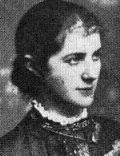Name Florence Balcombe Children Noel Thornley Stoker | Role Bram Stoker's wife | |
 | ||
Full Name Florence Anne Lemon Balcombe Parents James Balcombe, Phillippa Anne Marshall People also search for Bram Stoker, Noel Thornley Stoker, Abraham Stoker, Charlotte Mathilda Blake Thornley | ||
Lands of Dracula: Strange Relationship of Bram Stoker and Florence
Florence Balcombe (17 July 1858 – 25 May 1937) was the wife of Bram Stoker, whom she married in Dublin in 1878. She was the daughter of Lieutenant-Colonel James Balcombe of 1 Marino Crescent, Clontarf, and wife Phillippa Anne Marshall, and was a celebrated beauty whose former suitor was Oscar Wilde. Bram Stoker had known Wilde from his student days, having proposed him for membership of the university’s Philosophical Society while he was president. Wilde was upset at Florence's decision, but Stoker later resumed the acquaintanceship and after Wilde's fall visited him on the Continent.
Contents
The Stokers moved to London, where Stoker became acting-manager and then business manager of Henry Irving's Lyceum Theatre, London, a post he held for 27 years. On 31 December 1879, Bram and Florence's only child was born, a son that they christened Irving Noel Thornley Stoker.
Nosferatu
Balcombe is remembered for her legal dispute with the makers of the 1922 horror film Nosferatu, which was based without attribution or permission on Stoker's novel Dracula. She was unaware of the existence of Friedrich Wilhelm Murnau's Nosferatu until she received an anonymous letter from Berlin. The document included the program of a lavish cinematic event held in 1922, complete with full orchestral accompaniment, that had taken place in the Marble Garden at Berlin Zoological Garden. The German film was described in the handbill as "freely adapted from Bram Stoker's Dracula." (Nosferatu screenwriter Henrik Galeen had changed the names of the main characters and made some liberal changes to certain key points. However, the resemblance to Stoker's novel is unmistakable.)
Balcombe was struggling financially and, as Stoker's literary executor, had never given permission for the adaptation, nor received payment for it. Her furious response to this copyright infringement was prompt and uncompromising; not only did she want the financial reparation she felt was due to the estate, she demanded that the negative and all prints of the film (which she would never actually see) be immediately destroyed.
Balcombe launched a lawsuit in which she was represented by the lawyers of the British Incorporated Society of Authors. The suit took some time to resolve; at one point, the German production company Prana-Film declared bankruptcy to avoid paying for the adaptation. Finally, she won the case, with the final ruling in July 1925 stating that the negatives and all prints of the film should be handed over to her to be destroyed.
Despite this ruling, prints of the film slowly began to resurface in the late 1920s, with the first American screenings taking place in New York City and Detroit in 1929.
Balcombe did grant the rights to the stage adaptation of Dracula to Hamilton Deane, who had been a neighbour of hers in Dublin. The play premiered in Derby in 1924. In 1927 Horace Liveright bought the American dramatic rights from Florence and hired John L. Balderston to edit it for the New York stage. The show ran for a year on Broadway and for two more years on tour, breaking all previous records for any show put on tour in the United States. However, Liveright failed to pay Florence all her entitlements for the show - he died shortly afterwards.
Florence Balcombe outlived her husband by 25 years and died in 1937 at the age of 78. She was cremated at Golders Green Crematorium, and her ashes scattered at the Gardens of Rest there. The original plan had been to keep her ashes and those of her husband together in a display urn. After Irving Noel Stoker's death in 1961, his ashes were added to those of his father's in that urn.
